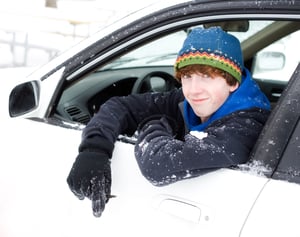 Letting your new teen driver navigate the roadways alone for the first time is one of the scariest things you’ll do as a parent. Compound that with winter weather, and letting your teen go is even harder. Of course, you know your son or daughter isn’t concerned in the least.
Letting your new teen driver navigate the roadways alone for the first time is one of the scariest things you’ll do as a parent. Compound that with winter weather, and letting your teen go is even harder. Of course, you know your son or daughter isn’t concerned in the least.
Every year, the first snowfall brings numerous accidents on our roadways. Even the most experienced drivers can find winter driving challenging and nerve-racking.
However, with coaching and practice, your teen driver can be prepared for what’s to come. Here are some tips to keep everyone in your family safe.
1. Take it slow. When the roads aren’t dry, it’s critical to slow down. While this seems like common sense, it’s easy to forget that defensive driving maneuvers don’t happen as quickly in the snow.
2. Brake properly. If your car has ABS (anti-lock braking system), you should press on the brake pedal and not let off. The purpose of the ABS is to prevent the wheels from locking in an emergency. By preventing the wheels from locking, you can continue to steer the car safely.
3. Invincibility is a myth. Inexperienced drivers often think that nothing’s going to happen to them. Unfortunately, nothing’s guaranteed, and accidents can happen in a split second.
4. Don’t be overconfident. Four-wheel drive and all-wheel drive systems allow for excellent traction in the snow. However, they don’t eliminate the science of physics. If you’re driving too fast for the current road conditions, you’re bound to lose control.
5. Don’t rely solely on technology. Significant technological advancements have been made with vehicle safety features. However, it’s important not to rely on them 100% of the time. Slippery conditions can occasionally outsmart the systems.
6. Keep a safe following distance. Experts recommend keeping at least three car lengths between you and the vehicle in front of you. If another car squeezes in front of you, back off.
7. Don’t pass snowplows. Getting stuck behind snowplows can be frustrating. However, passing snowplows can lead to deadly consequences. Remember, they’re trying to make the road safe for everyone. Here are some things to be aware of:
- If you pass them, the road in front of you hasn’t been cleared. This can lead to much more treacherous driving conditions.
- They may be taking up more of the road than you realize.
- Their auxiliary snowplow blade may be extended.
- You may enter a whiteout situation.
8. Pay attention to road surfaces. Paying attention to road surfaces can provide valuable information. When other vehicles pass me, I look at their tires to see what’s happening. If the road looks wet, tire spray should come from the tires. If there isn’t tire spray, there’s a good chance the road is icy. Also, don’t forget that bridges and overpasses freeze before the streets do. Let off the gas before driving on them.
9. Follow the path of least resistance. If snow accumulates rapidly on the roadways, it may be difficult for the snowplows to keep up. If possible, try to drive in the car's tracks in front of you. If the tracks go into the ditch, then it’s time to make your own tracks.
10. If you don’t need to go out, stay home. It’s not always possible to stay in the safety and comfort of your home. However, if weather forecasters predict life-threatening conditions, consider making alternative arrangements.
If you or your teen driver would like to practice winter driving in a safe environment, consider enrolling in Road America’s Winter Driving School, sponsored by West Bend.
The instructors at Road America teach techniques for handling different winter driving conditions. Those techniques include:
- Skid control and prevention
- Braking with ABS and without
- Collision avoidance maneuvers
- Proper vision skills
Lastly, if you don’t have roadside assistance, now may be a good time to check into different plans available.
Do you have any winter driving tips you’d like to share? I’d love to hear from you. Please share them in the box below.





